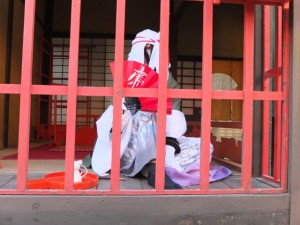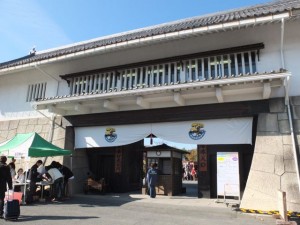On November 26th I visited the Toei Kyoto Studio Park for the Uzumasa Sengoku Festival. I’ve posted my photographs here. The Toei Park is cinema theme park with sets that are still used along with all sorts of activities for visitors like a Ninja show. It is a bit of tourist trap, but that is part of its charm for those who want to be photographed in “authentic” settings as you will see. The Uzumasa Sengoku Festival is a two-day festival dedicated to Japanese Warring Period transmedia (manga, anime and games) which made is a perfect venue to study the interplay between media and/for fans. For the festival there was a pavillion dedicated to gaming where local game companies had booths, there were special events and some of the houses in the “historic” Kyoto setting were used by companies to promote new products about popular warring period anime and related media. Above all the cosplay (costume play) fans came out in droves to pose for pictures in the recreated streets of old Kyoto.
I was invited to this Festival by Akinori Nakamura, one of the game studies professors at Ritsumeikan who was one of the organizers of the event. Students at Ritsumeikan’s College of Image Arts and Sciences were staffing the Festival and two helped myself and Jaakko Suominen understand what was going on by translating things. Ward was a Dutch MA student in Japanese Studies on exchange and Naoki was a Japanese student in his fourth year of the Image Arts and Science programme. Both spoke excellent English and helped us talk with booth staff and cosplayers. I’m grateful to Nakamura, Ward and Naoki for their help making sense of this wild event.
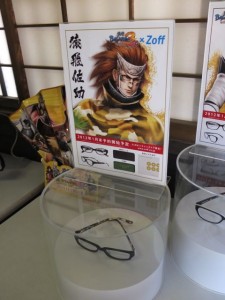
As far as I can tell, the theme of the Japanese warring period was not adherred too closely. The warring period or Sengoku period runs roughly from the mid 15th century to the late 16th, but as far as the Park and the Festival were concerned anything vaguely samurai-like was probably good enough. For that matter, the manga, anime and games that draw on that period for ideas often contain all sort of fantastical elements and transpositions from other eras. Nonetheless, the point wasn’t historical accuracy, despite the involvement of Ritsumeikan University, but celebration of a particularly Japanese historical warring aesthetic that crosses media here. The aesthetic of the samurai, their loyalties (and treachery), the ninja, rulers, armies and battles runs through a lot of the mixed-media franchises popular here. We could say that it is one of Japan’s contributions to global imaginative culture – every kid knows the basics of the samurai world, even if they don’t know its historical heritage or the realities of the age (like the oppresive feudal system that sustained it and how the long meaningless wars destroyed so much.) The Meiji period when the samurai class was disbanded and Japan modernized just doesn’t sell to youth the way the Sengoku period does.
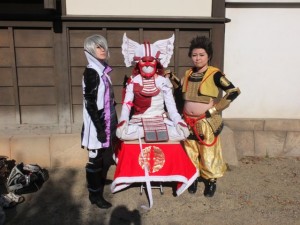
The most interesting feature of the festival was the cosplay presence. Mostly women in their 20s, they dressed up in costumes related to their favorite shows and games, especially Capcom’s Sengoku Basara (Japanese site) (and here is the English Wikipedia site.) These costumes varied from cheaper plastic ones that you might buy for Halloween to handmade costumes of great ingenuity. The cosplayers didn’t come to be seen by the larger public so much as to pose for photographs that they or their friends took in poses on location, so to speak. Jaakko did some research and it seems these photographs are then posted to cosplay social networks like the Cure Cosplay Community Site and printed on cards with their cosplay names and contact information and exchanged with other cosplayers. Here is an English web page from a Singaporean cosplayer describing the practices. Here is an English tutorial on how to make them.
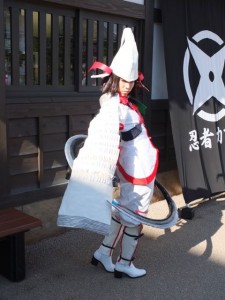
Near the end of the day we saw lines of cosplayers showing their albums to others and exchanging cards. I desperately wanted to question them about these albums and the etiquette of exchange, but felt it would intrude on their fan activities. As I understand it these cosplayers are usually part of loose clubs. They don’t post on public sites as they often don’t want their family or co-workers to know about this side of their life. For this reason the etiquette when taking a picture of them is to ask, even if four of their friends are lined up with enormous Japanese cameras taking their photos. The point is that they are not there to be seen by civilians like me, but to take advantage of the stage sets to add to the albums of photos they have of themselves and others as anime/game characters. Ever respectful, we asked everytime, and no one refused us.


The game pavillion opened at 1pm and was in a movie studio building that may still be used. There were a number of smaller local companies showing games they had worked. These companies tended to have about 50 staff of which smaller groups of 5 or so would work on a game. Many of these companies were developing casual games for mobile platforms and some offering services. One interesting game used both the Android and a PC in a fashion that suggests forms of gameplay that the Wii U may offer. The idea was to shoot shuriken (Ninja throwing stars) at targets. The PC game showed the targets while you stroked the touchscreen of the Android to aim and fire the shuriken. There was a company from Osaka that offers localization (translation) services for games from abroad. I recognized Machinarium in their list. In Studio 13 (the pavillion for gaming) they also had presentations. I saw a developer demonstrating a forthcoming game 4am from PixelJunk for the PS3. It is musical visual toy that uses the Sony Move wand to let yo pull sequences out of a three space and then conduct music with them. It seemed designed to show off the capabilities of the Move and had nothing to do with warring Japan.
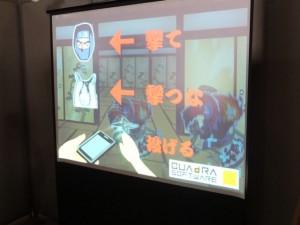
Kyoto was where the original Japanese film industry got started before it moved to Tokyo (like the Emperor.) The Park is what is left, both in the sense that they still have a working studio here, and that the Park celebrates the early years and the shows produced here. I’m guessing that, as less and less is filmed in the Park, it becomes more and more of a nostalgic film theme park. Some of the activities available include shows like the Ninja show we saw. You can also pay to be made up and dressed up like a Geisha, Samurai or Ninja to then be photographed. There was a haunted house that I skipped and they are building an even larger one. There were lots of restaurants and gift shops, needless to say. They have learned the theme park lesson that the greatest entertainment of all is to shop. In addition to all the folk there for the Festival there were Japanese families out for a Saturday holiday.
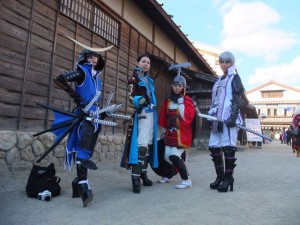
Transmedia is phenomenon that is not unique to Japan, but it is characteristic of how many Japanese games are consumed and positioned. Many games are developed from popular anime or manga (and vice versa.) The Pokemon phenomenon is an example. It started as a game, but an animated cartoon series followed as did playing cards connected to the game and all sorts of other swag. Kids rarely consume only one media in the franchise which is why we need to understand the interaction between the media to understand the place of a game. How do kids go from watching the Pokemon cartoon to (re)playing the game? There would also seem to be a pattern of evolution from manga to anime to games. A popular manga like One Peice will have an anime series developed around it and then games. This way an idea is developed inexpensively as manga and if successful and there is a fan base, the greater investment needed for anime and then games is made. I’m not sure there is the same pattern of development in the West, though large budget science fiction and fantasy movies like Star Wars or Avatar are almost always developed with accompanying games that extend the reach of the franchise. My sense is that in the West we tend to consume our media separately more often than not. I’ll play a Batman game if it is recommended as a good game, not because I like the movies. In fact, I distrust games made from movies and vice versa. In Japan fans of a franchise want more of the world and make a committment to that world that experesses itself in its extreme form in the cosplay clubs around a franchise. See Azuma’s Otaku, Japan’s Database Animals for more on that.
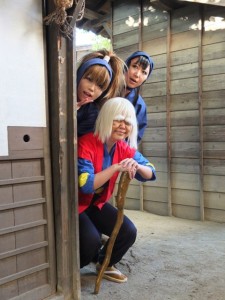
Another common fan activity here in Japan is the creation of fan manga or anime that fans can then sell at the regular markets or through stores that sell the stuff. One is tempted to say that Japanese fans are more committed, but that would ignore the trekkie phenomenon that may predate fan activities here. Anyway, festivals like the Uzumasa Sengoku Festival bring together vendors and fans of a genre of transmedia phenomena. In one place the fans of this time period and genre of play world can gather, pose for photographs, meet up with other groups, and buy paraphenalia (though there was less of that.)
